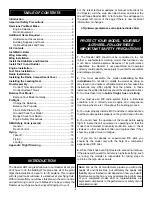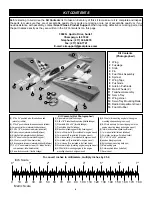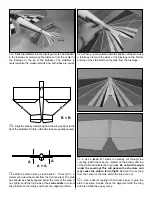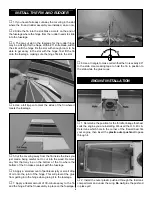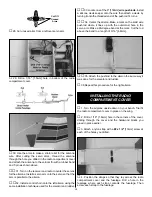
Make sure the control surfaces move in the proper direction as
illustrated in the above sketch.
Note: This section is VERY important and must NOT be
omitted! A model that is not properly balanced will be
unstable and possibly unflyable.
❏
1. The balance point (C.G.) is located 3" [75mm] back
from the leading edge of the wing. Balance your Dazzler
using a Great Planes C.G. Machine
™
Airplane Balancer
(GPMR2400) for the most accurate results. This is the
balance point at which your model should balance for your
first flights. After initial trim flights and when you become more
acquainted with your Dazzler, you may wish to experiment by
shifting the balance up to 1/4" [6mm] forward or backward to
change its flying characteristics. Moving the balance forward
may improve the smoothness and stability, but the model may
then require more speed for takeoff and may become more
difficult to slow for landing. Moving the balance aft makes the
model more agile with a lighter, snappier “feel” and often
improves knife-edge capabilities. In any case, please start at
the location we recommend. Do not at any time balance your
model outside the recommended range.
❏
2. With all parts of the model installed (ready to fly) and
an empty fuel tank, block up the tail as necessary to level the
stab. Lift the model at the desired balance point and observe
the tail of the aircraft. If the tail drops, the model is “tail
heavy” and you must add weight to the nose to balance the
model. If the nose drops, it is “nose heavy” and you must add
weight* to the tail to balance the model.
Note: Nose weight may be easily installed by using a
“spinner weight.” Tail weight may be added by using Great
Planes (GPMQ4485) “stick-on” lead weights.
IMPORTANT: Do not confuse this procedure with “checking
the C.G.” or “balancing the airplane fore and aft.”
Now that you have the basic airplane nearly completed, this
is a good time to balance the airplane laterally (side-to-side).
Here is how to do it:
❏
1. Make sure the fuel tank is empty.
❏
2. With the wing level, lift the model by the engine propeller
shaft and the fin post (this may require two people). Do this
several times.
If one wing always drops when you lift the model, it means
that side is heavy. Balance the airplane by adding weight to
the opposite, lighter wing tip.
Note: An airplane that has been laterally balanced will track
better in loops and other maneuvers.
At this time check all connections including servo horn
screws, clevises, servo cords and extensions.
Follow the battery charging procedures in your radio
instruction manual.You should always charge your transmitter
and receiver batteries the night before you go flying and at
other times as recommended by the radio manufacturer.
Charge the Batteries
PREFLIGHT
Balance Your Model Laterally
BALANCE YOUR MODEL
CARBURETOR WIDE OPEN
RUDDER MOVES RIGHT
LEFT AILERON MOVES DOWN
RIGHT AILERON MOVES UP
ELEVATOR MOVES UP
4-CHANNEL
TRANSMITTER
(STANDARD MODE 2)
4-CHANNEL RADIO SETUP
TRANSMITTER
4-CHANNEL
TRANSMITTER
4-CHANNEL
TRANSMITTER
4-CHANNEL
16

